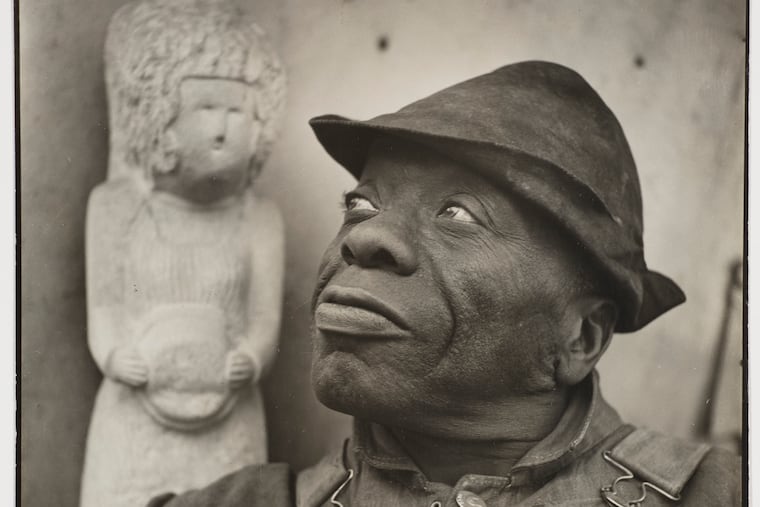From a Chestnut Hill porch to the Barnes Foundation, by way of PMA, a long-lost sculpture finds it way
A self-taught sculptor from Nashville, renowned Outsider artist William Edmondson created 'Miss Louisa' to honor an unrequited love.

In the early 1990s, John Ollman, the longtime Philadelphia gallerist, needed to find the rare and stunning stonework of sculptor William Edmondson for his forthcoming show. A self-taught sculptor from Nashville, Edmondson was an undeniable talent in the art world and Ollman fell in love with his smooth and curvy limestone figures.
While searching, Ollman received a surprising call from someone promising an Edmondson work that had been considered lost for decades.
Paul W. McCloskey, living in Chevy Chase, Md., had heard of Ollman’s show, and had met Edmondson while he was stationed in Nashville during World War II. Contrary to what Edmondson’s followers believed for 50 years, the sculpture Miss Louisa wasn’t lost — she had been sitting on McCloskey’s parents’ porch in Chestnut Hill.
“I said, ‘Oh, my God, that piece has been lost forever!’ And he said, ‘No, it wasn’t, I knew where it was — nobody was smart enough to find out where it went,’ ” Ollman, 81, recalled, laughing.
The gallerist, who lives in Bella Vista and runs the Fleisher / Ollman Gallery in Callowhill, used Miss Louisa in his 1995 show before helping McCloskey donate the work to the Philadelphia Museum of Art.
Currently, Miss Louisa is one of the 60-plus Edmondson sculptures on display at the Barnes Foundation in “William Edmondson: A Monumental Vision,” running through Sept. 10.
During their 1995 call, McCloskey relayed to Ollman that at some time in the 1940s he had noticed Miss Louisa in the window of a bank and visited Edmondson’s home, where the front yard was his workshop. It was rare to meet a collector who had purchased from Edmondson directly, Ollman said. So he grilled McCloskey for information, first for the provenance of Miss Louisa and second, to hear more about the legendary sculptor who was the first Black artist to have a solo show at New York’s Museum of Modern Art.
Edmondson, now a prestigious Outsider artist whose sculptures have sold for as much as $785,000, was the son of a formerly enslaved couple. He worked as a railroad worker, farmhand, and hospital orderly before picking up limestone carving later in his life around 1932. He said that God came to him in a vision and instructed him to begin carving tombstones, which he crafted for Black cemeteries in Nashville before continuing to sculpt other figures, like Eleanor Roosevelt, which is also in the Barnes exhibit. (Another sculpture on view, Martha and Mary, had been considered lost for many years before a collector saw it on a porch in St. Louis in 2019; he called it a “Holy Grail.”)
Just a few years into his efforts at chiseling limestone into angels, animals, and depictions of his neighbors, Edmondson had a solo exhibition at MoMA in 1937. Though his talent was given enormous recognition, the art world and newspapers viewed Edmondson through racist and degrading stereotypes. Media coverage focused on his lack of formal education and called him a “modern primitive.”
Some of the most popular images of Edmondson were taken by Louise Dahl-Wolfe of Harper’s Bazaar, who visited his Nashville home and photographed him at work.
“One of the challenges with those images is that they played into stereotypes about Black creativity in the 1930s,” said Nancy Ireson, chief curator at the Barnes. “Edmondson was rural, he was unschooled, things that were framed in very pejorative terms at the time. So how do you try and look at those images again and actually sense his agency within them?”
Ireson and her cocurator for the exhibit, James Claiborne, felt the images (that show Edmondson in tattered clothes and broken shoes, feeding into racist narratives) were important to include in the Barnes’ reexamination of Edmondson. The show isn’t simply about granting a greater platform to an artist who was largely overlooked during his lifetime; the exhibit is candid about the ways that racism affected Edmondson’s reception in the art world at the time.
In one of Dahl-Wolfe’s images, Edmondson stands in front of Miss Louisa. Shortly afterward, the sculpture fell out of public view when McCloskey bought and shipped it to Philadelphia. The photo is partially autobiographical for the sculptor, too.
When McCloskey asked about the sculpture’s inspiration, Edmondson told him that she represented an unrequited love. The woman stands holding a hat because she is returning it to a suitor whose proposal of marriage she had rejected. The suitor, the artist implied, was Edmondson himself.
The sculptor posed with Miss Louisa in 1937. As he stares into the sky with a soft smile, he looks hopeful and incredibly poised. Maybe God told him, too, that nearly 90 years later, the world would still be studying the depths of his creative imprint, attempting to understand his visions for decades to come.
“William Edmondson: A Monumental Vision” runs at the Barnes Foundation through Sept. 10.